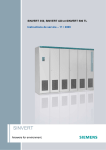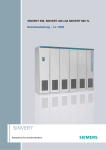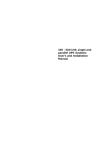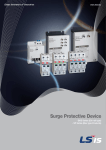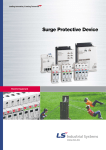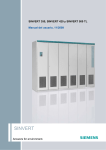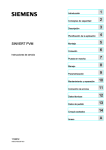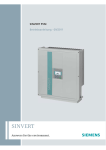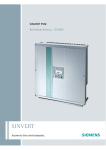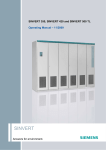Download Siemens TL.. Operating instructions
Transcript
SINVERT 350, SINVERT 420 and SINVERT 500 TL Operating Instructions – 11/2009 SINVERT Answers for environment. Introduction 1 Description 2 Application 3 Installation 4 Support 5 SINVERT SINVERT 350, SINVERT 420 and SINVERT 500 TL Operating Instructions Edition 11/2009 Safety instructions These Operating Instructions contain information which you should observe to ensure your own personal safety as well as to protect the product and connected equipment. The notices referring to your personal safety are highlighted in the manual by a safety alert symbol. Notices referring only to equipment damage have no safety alert symbol. Warnings are shown in descending order according to the degree of danger as follows. DANGER indicates that death or severe personal injury will result if proper precautions are not taken. WARNING indicates that death or severe personal injury may result if proper precautions are not taken. CAUTION with a safety alert symbol indicates that minor personal injury can result if proper precautions are not taken. CAUTION without a safety alert symbol indicates that damage to property may result if proper precautions are not taken. CAUTION indicates that an unwanted result or state may occur if the relevant instruction is not observed. In the event of a number of levels of danger prevailing simultaneously, the warning corresponding to the highest level of danger is always used. A warning that uses a safety alert symbol indicating possible personal injury may also include a warning relating to material damage. Qualified personnel The associated equipment / system may only be set up and operated in conjunction with this documentation. Commissioning and operation of a device/system may only be performed by qualified personnel. For the purpose of the safety information in these Operating Instructions, a "qualified person" is someone who is authorized to energize, ground, and tag equipment, systems, and circuits in accordance with established safety procedures. Proper handling Note the following: WARNING The equipment may only be used for the applications specified in the catalog and technical description and only in conjunction with non-Siemens equipment and components if these have been specifically recommended or approved by Siemens. This product can function correctly and reliably only if it is transported, stored, assembled, and installed correctly, and operated and maintained as recommended. Trademarks All names shown with the trademark symbol ® are registered trademarks of Siemens AG. Third parties using for their own purposes any other names in this document which refer to trademarks might infringe upon the rights of the trademark owners. Disclaimer of liability We have checked that the contents of this document correspond to the hardware and software described. However, since deviations cannot be precluded entirely, we cannot guarantee full consistency. The information given in this publication is reviewed at regular intervals and any corrections that might be necessary are made in the subsequent editions. Siemens AG Ⓟ 11/2009 Copyright © Siemens AG 2009 Subject to change Contents 1 Introduction ........................................................................................................ 8 1.1 About this documentation............................................................................ 8 1.1.1 1.1.2 1.1.3 2 Description ....................................................................................................... 10 2.1 3 Scope of validity ...................................................................................... 8 Target group ............................................................................................ 9 History ..................................................................................................... 9 Application................................................................................................. 10 Application ....................................................................................................... 12 3.1 Scope of delivery....................................................................................... 12 3.2 Dimensions and weights ........................................................................... 13 3.3 Configuration of the inverters .................................................................... 14 3.4 Medium-voltage components .................................................................... 16 3.5 Footprint .................................................................................................... 18 3.6 Installation requirements ........................................................................... 19 3.7 Ambient conditions .................................................................................... 20 3.7.1 3.7.2 3.7.3 Storage .................................................................................................. 20 Transport ............................................................................................... 20 Operation............................................................................................... 20 3.8 Cooling air inlet.......................................................................................... 21 3.9 Cooling air flow for inverters ...................................................................... 22 3.10 Cable entry ................................................................................................ 24 3.11 Grounding and lightning protection ........................................................... 25 3.11.1 3.11.2 3.12 Delivery of the inverters............................................................................. 27 3.13 Storage...................................................................................................... 28 3.14 Shipping .................................................................................................... 29 3.14.1 3.14.2 3.15 General safety guidelines .................................................................. 31 Center of gravity marking .................................................................. 33 Moving the cabinets .................................................................................. 34 3.15.1 3.15.2 3.15.3 3.15.4 4 Grounding concept ............................................................................ 25 Lightning protection ........................................................................... 26 Lifting the DC and drive cabinet ........................................................ 35 Lifting the SINVERT 350 and SINVERT 420 AC cabinet .................. 37 Lifting the SINVERT 500 TL AC cabinet............................................ 38 Lifting the cabinet off the transport pallet........................................... 39 Installation ........................................................................................................ 41 4.1 Installation requirements ........................................................................... 41 4.2 Mechanical installation .............................................................................. 42 4.2.1 4.2.2 4.3 4.3.1 4.3.2 4.3.3 Screwing the transport units together.................................................... 43 Bolting the cabinets to the floor ............................................................. 44 Electrical installation.................................................................................. 45 Observe the five safety rules ................................................................. 46 External cable connections.................................................................... 47 Connecting the power cables and control cables .................................. 48 4.4 4.4.1 4.4.2 5 Communication ......................................................................................... 57 Profibus ................................................................................................. 58 RS422/Ethernet ..................................................................................... 59 Support ............................................................................................................. 60 5.1 Contact addresses .................................................................................... 60 Tables Table 3-1 SINVERT 350 dimensions and weights ....................................................... 13 Table 3-2 SINVERT 420 dimensions and weights ....................................................... 13 Table 3-3 SINVERT 500 TL dimensions and weights................................................... 13 Table 3-4 Ambient conditions for storage.................................................................. 20 Table 3-5 Ambient conditions for transport ............................................................... 20 Table 3-6 Ambient conditions for operation .............................................................. 20 Table 4-1 External cable connections ........................................................................ 47 Figures Figure 2-1 Overview of PV system ............................................................................. 10 Figure 2-2 SINVERT 420 M ......................................................................................... 11 Figure 2-3 SINVERT 420 M with doors opened .......................................................... 11 Figure 2-4 SINVERT 500 TL ........................................................................................ 11 Figure 3-1 Example of inverter configuration ............................................................ 14 Figure 3-2 Example of configuration with two adjacent inverters ............................. 15 Figure 3-3 Example of configuration of two inverters ............................................... 15 Figure 3-4 Configuration of medium- and low-voltage components ......................... 16 Figure 3-5 Separate installation of medium- and low-voltage components............... 16 Figure 3-6 Pressure relief for medium-voltage switchgear......................................... 17 Figure 3-7 Footprint of SINVERT 350, 420, or 500 TL ................................................ 18 Figure 3-8 Cooling air inlet cutouts for SINVERT 350, 420, or 500 TL ........................ 21 Figure 3-9 Airflow in inverter cabinets....................................................................... 22 Figure 3-10 Example: Airflow in an inverter station................................................... 23 Figure 3-11 The use of air channels for inverters is not permissible .......................... 23 Figure 3-12 DC and drive cabinet .............................................................................. 29 Figure 3-13 SINVERT 350 or SINVERT 420 AC cabinet................................................ 29 Figure 3-14 Impermissible tipping of the inverter ..................................................... 31 Figure 3-15 Center of gravity marking....................................................................... 33 Figure 3-16 Center of gravity marking on inverter..................................................... 33 Figure 3-17 Correct handling with crane and transport plates................................... 35 Figure 3-18 Correct handling: Transporting the inverter in a straight line ................. 35 Figure 3-19 Incorrect handling: Swinging or tipping the inverter cabinet ................. 35 Figure 3-20 Transport by crane: Ropes of different lengths are not allowed ............. 35 Figure 3-21 Transport by forklift................................................................................ 36 Figure 3-22 Impermissible transport by forklift: Loading from the front side ............ 36 Figure 3-23 Crane hooks ........................................................................................... 37 Figure 3-24 SINVERT 500 TL AC cabinet..................................................................... 38 Figure 3-25 Location of screws on the DC and drive cabinet ..................................... 39 Figure 3-26 Location of screws on the AC cabinet ..................................................... 39 Figure 3-27 Moving the cabinet off the standard pallet............................................. 39 Figure 4-1 Mounting set for cabinet connection........................................................ 43 Figure 4-2 Screwing together transportation units.................................................... 43 Figure 4-3 Accessory kit ferrite rings.......................................................................... 48 Figure 4-4 Cable connection inverter – drive............................................................. 49 Figure 4-5 Position Cable connection inverter – DC link ............................................ 50 Figure 4-6 Cable connection inverter – DC link.......................................................... 50 Figure 4-7 Cable routing for DC link 2 inverters......................................................... 51 Figure 4-8 Cable routing for DC link 3 inverters......................................................... 51 Figure 4-9 Cable routing for DC link4 inverters.......................................................... 51 Figure 4-10 Cable connection for AC power supply ................................................... 52 Figure 4-11 SINVERT 500 TL AC power cable connection .......................................... 52 Figure 4-12 Strain relief for cables............................................................................. 52 Figure 4-13 Position of the terminal strip-OPT in the SINVERT 350/420..................... 53 Figure 4-14 Position of the terminal strip -OPT in the SINVERT 500 TL ...................... 54 Figure 4-15 Cable connection for DC power supply................................................... 55 Figure 4-16 Connection of the control cables............................................................ 56 Figure 4-17 SINVERT communication scheme ........................................................... 57 Figure 4-18 Profibus connection................................................................................ 58 Figure 4-19 Profibus cable routing for a master/slave combination........................... 58 Figure 4-20 Cable routing of the RS422 bus .............................................................. 59 Figure 4-21 Rear of operator panel............................................................................ 59 Figure 4-22 Com server ............................................................................................. 59 Introduction 1.1 About this documentation 1 Introduction 1.1 About this documentation This manual will provide you with guidance in the use of SINVERT PV inverters. It provides you with a detailed overview of all the information you need to know about SINVERT PV inverters. We have checked that the contents of this document correspond to the hardware and software described. However, since deviations cannot be precluded entirely, we cannot guarantee full consistency. The information given in this publication is reviewed at regular intervals and any corrections that might be necessary are made in the subsequent editions. We would be pleased to receive any feedback or suggestions for improvements from you. You will find our contact details in Chapter 5 "Support". 1.1.1 Scope of validity This system manual is valid for the following basic models of the SINVERT PV inverter: • SINVERT 350 M • SINVERT 420 M • SINVERT 500 M TL and their master-slave variants: • SINVERT 700 MS (two SINVERT 350 inverters in parallel) • SINVERT 1000 MS (three SINVERT 350 inverters in parallel) • SINVERT 1400 MS (four SINVERT 350 inverters in parallel) • • • SINVERT 850 MS (two SINVERT 420 inverters in parallel) SINVERT 1300 MS (three SINVERT 420 inverters in parallel) SINVERT 1700 MS (four SINVERT 420 inverters in parallel) • • • SINVERT 1000 MS TL (two SINVERT 500 TL inverters in parallel) SINVERT 1500 MS TL (three SINVERT 500 TL inverters in parallel) SINVERT 2000 MS TL (four SINVERT 500 TL inverters in parallel) 8 Introduction 1.1 About this documentation 1.1.2 Target group This documentation contains information of interest to the following target groups: • • • Installation personnel Commissioning personnel Service personnel 1.1.3 History Currently released editions of this manual: Edition Remark 11/2009 First edition 9 Description 2.1 Application 2 Description 2.1 Application The SINVERT PV inverter is a fully assembled, ready-to-connect inverter unit for PV installations. 1 2 3 Figure 2-1 Overview of PV system 1 The inverter transforms the DC voltage produced by the PV modules into an AC voltage. 2 The AC output voltage is transformed to the grid voltage by a medium-voltage transformer. 3 The PV solar system can thus be connected to the medium-voltage grid. 10 Description 2.1 Application Figure 2-2 SINVERT 420 M Figure 2-3 SINVERT 420 M with doors opened Figure 2-4 SINVERT 500 TL 11 Application 3.1 Scope of delivery 3 Application 3.1 Scope of delivery The scope of delivery includes: • Inverter cabinet with • PROFIBUS cable, 1x10 mm diameter • RS422 cable, 1x10 mm diameter • Circuit manual • Operating Instructions • Operating Manual • PP solar CD • Ferrite • Mounting set for cabinet connection • Accessory kit with • DC link cable with M12 cable lug, diameter approx. 35 mm The option to extend the switch-on voltage to 900 V DC (DC chopper) includes the following accessory pack • • • Braking resistor 2x70 mm² (black) 15 m each for braking resistor, M8 cable lugs at both ends 1x35 mm² (yellow/green) 15 m each for braking resistor, cover on one end, M8 cable lug on the other 12 Application 3.2 Dimensions and weights 3.2 Dimensions and weights The inverters have the following weights and dimensions (with and without transport pallet): Table 3-1 SINVERT 350 dimensions and weights Height [mm] Width [mm] Depth [mm] Weight [kg] Without pallet, DC and drive 2000 1800 800 730 Without pallet, AC cabinet 2000 900 800 1330 With pallet, DC and drive 2235 1850 950 790 With pallet, AC cabinet 2130 1000 950 1360 Height [mm] Width [mm] Depth [mm] Weight [kg] Without pallet, DC and drive 2000 1800 800 970 Without pallet, AC cabinet 2000 900 800 1630 With pallet, DC and drive 2235 1850 950 1030 With pallet, AC cabinet 2130 1000 950 1660 Height [mm] Width [mm] Depth [mm] Weight [kg] Without pallet, DC and drive 2000 1800 800 970 Without pallet, AC cabinet 2000 900 800 780 With pallet, DC and drive 2235 1850 950 1030 With pallet, AC cabinet 2130 1000 950 810 SINVERT 350 The SINVERT 350 has a total weight of 2060 kg. Table 3-2 SINVERT 420 dimensions and weights SINVERT 420 The SINVERT 420 has a total weight of 2,600 kg. Table 3-3 SINVERT 500 TL dimensions and weights SINVERT 500 TL The SINVERT 500 TL has a total weight of 1,750 kg. 13 Application 3.3 Configuration of the inverters 3.3 Configuration of the inverters The following is the preferred configuration for the SINVERT 1400 MS (four SINVERT 350 in parallel), SINVERT 1700 MS (four SINVERT 420 in parallel), or SINVERT 2000 MS TL (four SINVERT 500 TL in parallel) in an equipment room: Figure 3-1 Example of inverter configuration 14 Application 3.3 Configuration of the inverters The following is the preferred configuration for the SINVERT 700 MS (two SINVERT 350 in parallel), SINVERT 850 MS (two SINVERT 420 in parallel), or SINVERT 1000 TL (two SINVERT 500 TL in parallel) in an equipment room: Figure 3-2 Example of configuration with two adjacent inverters Figure 3-3 Example of configuration of two inverters 15 Application 3.4 Medium-voltage components 3.4 Medium-voltage components Figure 3-4 Configuration of medium- and low-voltage components Figure 3-5 Separate installation of medium- and low-voltage components 16 Application 3.4 Medium-voltage components Figure 3-6 Pressure relief for medium-voltage switchgear Covers for pressure relief openings and associated air channels, expanded metal grids, etc., are not part of the switchgear and shall be provided by the customer. The dimensions of the room and the necessary pressure relief openings depend on the type of switchgear and the amount of short-circuit current. If pressure relief openings are required, these are to be arranged such that, based on their function (blowing out in the event of an arc) there is only a minimal risk of personal injury and property damage. The transformer room must be well ventilated and offer the necessary electrical clearances. The relevant fire safety and environmental regulations are to be observed depending on the type of transformer (oil or resin transformer). 17 Application 3.5 Footprint 3.5 Footprint The following diagram shows the inverter footprint: Figure 3-7 Footprint of SINVERT 350, 420, or 500 TL 18 Application 3.6 Installation requirements 3.6 Installation requirements The base of the inverter station must have sufficient capacity to carry the weight of the inverter. The inverter station must be designed for the wind and snow loads present at the installation site. The inverter cabinets can be placed close to walls. An air gap of at least 20 mm is required. To ensure adequate ventilation, the necessary distance to the ceiling must be maintained. A minimum distance of 400 mm must be observed. Air channels are not permissible. The air inlets (on the front and underneath) and the air outlet (on the top) on the inverter cabinet must not be covered or blocked. Blocking the air inlet leads to a rise in temperature inside the inverter. As a result, the inverter performance can be reduced or it can be switched off. Enough space must be provided in front of the cabinets so that easy access is ensured, for example, for maintenance work on the inverter. An appropriate escape route should also be kept clear. With the cabinet doors fully open, the passage width must be at least 500 mm. With closed cabinet doors, the passage must be at least 800 mm but should not exceed 1500 mm. The units may be installed next to each other without a gap. Further assembly requirements may arise due to local regulations, for example in areas with high risk of earthquakes or other increased risks. 19 Application 3.7 Ambient conditions 3.7 Ambient conditions 3.7.1 Storage Table 3-4 Ambient conditions for storage 3.7.2 Ambient temperature -25 °C to 70 °C Relative humidity ≤85%, non-condensing Transport Table 3-5 Ambient conditions for transport Ambient temperature -25 °C to 70 °C Relative humidity ≤85%, non-condensing 3.7.3 Operation Table 3-6 Ambient conditions for operation Ambient temperature 0 °C to 50 °C (with derating) Relative humidity ≤85%, non-condensing Other climate conditions according to class 3K3 according to IEC 60 721-3-3 Chemically active substances in accordance with class 3C2 according to IEC 60 721 3-3 20 Application 3.8 Cooling air inlet 3.8 Cooling air inlet The inverters must be provided with cooling air through the floor. The required floor cutouts for an inverter are shown in the following diagram: Figure 3-8 Cooling air inlet cutouts for SINVERT 350, 420, or 500 TL CAUTION Danger of mechanical damage Inverters with low-voltage transformers must be provided with cooling air through the floor. Insufficient cooling will lead to mechanical damage. 21 Application 3.9 Cooling air flow for inverters 3.9 Cooling air flow for inverters For air intake from below, the inverter must be installed above an open lower floor (cooling air inflow and cable entry from below). The requirements for cooling air are: Each SINVERT 350 requires 5400 m³ per hour at a temperature of max. 40 °C. Each SINVERT 420 requires 6,000 m³ per hour at a temperature of max. 40 °C. Each SINVERT 500 TL requires 4,800 m³ per hour at a temperature of max. 40 °C. Figure 3-9 Airflow in inverter cabinets 22 Application 3.9 Cooling air flow for inverters Figure 3-10 Example: Airflow in an inverter station Figure 3-11 The use of air channels for inverters is not permissible 23 Application 3.10 Cable entry 3.10 Cable entry The required cable entries for an inverter are: • 8 x 95-300 mm² single core; four DC 250 A inputs • 8 x 300 mm² single core; AC outputs L1,L2,L3 + PEN 630 A (if the medium-voltage transformer is not located in a container) • Communications cable (according to the desired communications options) All cables must be suitable for outdoor use. Examples: • Power cables: NYY-O 24 Application 3.11 Grounding and lightning protection 3.11 Grounding and lightning protection Building lightning strike protection is described in IEC 62305-3 (EN 62305-3). Among other things, this standard establishes the classification of individual lightning strike protection systems and indicates the resulting lightning strike protection measures required. Grounding and lightning strike protection are to be set up in conformance with IEC62305. 3.11.1 Grounding concept The design and dimensioning of the grounding system are the main criteria for channeling the lightning current into the ground (high-frequency behavior) and to reduce dangerous peak currents. In accordance with DIN EN 62305-3 a low grounding resistance (under 10 Ω, measured at a low frequency) is recommended. To avoid high potential differences between the various grounding systems, these are all connected to the same grounding system. This is done by connecting the electrical operating areas and the PV field grounding systems to a comprehensive meshed grounding system. By meshing all grounding systems, potential differences between the various plant parts are greatly reduced. In addition, lightning-induced voltage loads on the electrical interconnections between the buildings are also reduced. Mesh sizes of 20 m x 20 m up to 40 m x 40 m have proved economically and technically useful in larger PV systems. 25 Application 3.11 Grounding and lightning protection 3.11.2 Lightning protection A lightning protection system consists of an external lightning protection system and an internal lightning protection system. Using appropriate external lightning protection, the effect of a direct lightning strike into a building can be mitigated in a controlled way, and the lightning current can be discharged into the ground. Measures in an external lightning protection include a lightning collector, a lightning arrester, and a grounding system. The task of a lightning collector is to prevent direct lightning strikes. The arrangement and positioning of lightning collectors can be established using three methods: • Rolling ball method • Mesh method • Protection angle method If the inverter station has a roof made of metal that runs around the roof corners, lightning rods can be attached to the corners of the station roof. The lightning conductor has the task of passing the captured lightning current to a grounding system without leading to undue rises in temperature and mechanical damage. In a Class III lightning protection system, the typical distance between the lightning conductors in the same system is 15 m. The lightning conductors should be connected to the metal roof and must lead directly to the grounding system. Measures for interior lightning protection to protect the inverter against mechanical damage include a surge arrester (Classes I and II) and central potential equalization. Each inverter station must be provided with central equipotential bonding connected to the grounding system. 26 Application 3.12 Delivery of the inverters 3.12 Delivery of the inverters Please check that the consignment is complete against the accompanying dispatch documentation. If any items are missing from the consignment, please notify the relevant contact person immediately. 27 Application 3.13 Storage 3.13 Storage For the storage of the inverter units, the following conditions must be strictly observed. • • The inverters are intended for indoor installation in a clean and dry environment. They must be protected against temperature extremes (min. 25°C and max. 70°C) and excessive humidity (max. 85%). In the event of ingress of dirt or liquid into the equipment, formation of condensation, damage or any other failures to comply with the prescribed storage conditions, the equipment must not be commissioned until the correct remedial procedure has been discussed with and approved by Siemens AG. In the case of noncompliance with the above, Siemens AG will not accept liability for damage arising from unauthorized commissioning. Note Risk to life! Unauthorized commissioning! Cabinets which have been stored in conditions that do not meet the prescribed standard must not be commissioned. Failure to comply with storage standards may result in electric shock, other serious injury or substantial property damage. 28 Application 3.14 Shipping 3.14 Shipping In the following sections, note the following: • "Transportation unit" refers to the converter cabinet before it has been unpacked; • "Cabinet" refers to the converter cabinet after it has been unpacked A SINVERT 350, 420, or 500 TL inverter is delivered in two transportation units. The first transportation unit consists of a DC and drive cabinet, made up of two cabinets screwed together. The second transportation unit is the AC cabinet. The following diagrams show the two parts of the inverter: Figure 3-12 DC and drive cabinet Figure 3-13 SINVERT 350 or SINVERT 420 AC cabinet 29 Application 3.14 Shipping Before moving the converter boxes to their final installation site, it is recommended that the cable for the DC input and the AC main power connection are first routed and prepared. Since the cables are very rigid, moving and connecting them after cabinet installation can be very difficult. The inverter cabinets are mounted on transport pallets as standard. They can thus be moved by forklift or pallet truck. 30 Application 3.14 Shipping 3.14.1 General safety guidelines Pay attention to the safety-related instructions in this section and on the packaging for: • transport • storage • proper handling In this way you will prevent personal injury and material damage. Particular care must be taken during transportation and handling to ensure that no components are bent and/or no alterations made to isolating distances. WARNING Transportation in accordance with proper procedures If you lift and transport the device incorrectly or use impermissible means of transport, this can result in death, serious injury, or material damage. The transport unit/cabinet is heavy. The center of gravity is in the upper half of the cabinet. This can cause the device to topple over. The transport unit/cabinet must only be transported by trained personnel using the permitted means of transportation and lifting equipment. The devices must not pushed over or tipped. Figure 3-14 Impermissible tipping of the inverter 31 Application 3.14 Shipping Tipping the cabinet too far can cause it to topple over and may damage the transport pallet (see figure 33). Tipping the cabinet may cause serious personal injury or substantial material damage. It is therefore essential that you read and carefully follow the safety notice below: WARNING Risk to life! Tipping! A cabinet, whether with or without pallet, must never be tipped in any direction. The cabinet is very heavy. Tipping it too far and causing it to topple over can therefore result in serious injury, death and substantial property damage. The cabinets are screwed together with transport locks (upward-pointing screws) on the pallet. For safety reasons, these screws must be checked before moving the cabinet. Otherwise there is a risk the cabinets will tip over during transport. Like all electrical systems, the inverter cabinets must also be handled carefully and in compliance with the instructions of this manual. They must be handled in compliance with all safety regulations. For proper handling, all necessary aids should be used. The proper transportation and storage, along with careful operation and maintenance procedures, play an essential role for the proper and safe operation of the device. WARNING The device may not be exposed to any mechanical shock or vibration during transport and storage. The device must be protected from moisture (rain) and extreme temperatures. Improper lifting or transport of the device can lead to accidents with serious injuries or even fatalities and considerable property damage. 32 Application 3.14 Shipping 3.14.2 Center of gravity marking The transport unit/cabinet is heavy. The center of gravity is in the upper half of the cabinet. This can cause the device to topple over. The weight distribution is indicated directly on the inverter (see figure 3-5) by the center of gravity marking in accordance with ISO 780/symbol 7. Figure 3-15 Center of gravity marking Figure 3-16 Center of gravity marking on inverter WARNING Take center of gravity into account A sticker or stamp showing the precise specifications regarding the center of gravity of the cabinet is attached on each transportation unit. Failure to take into account the center of gravity can result in death, severe injury, or material damage. You must take into account the center of gravity during transportation. 33 Application 3.15 Moving the cabinets 3.15 Moving the cabinets The transport unit/cabinet should be transported with extreme care. Driving over bumps should be avoided whenever possible. It should be noted that force is exerted via the pallet during transport and in positioning the transportation unit on the forklift. When using a crane, the allowable transport weight and the center of gravity should be observed. If the center of gravity is not in the middle of the cabinet, appropriate and undamaged lifting equipment must always be used (e.g. transport plates). A transport plate reduces the force exerted on the device and prevents damage. WARNING Transportation in accordance with proper procedures Improper movement of the transportation unit with a crane can cause the device to fall or tip over, which can lead to accidents resulting in death, serious injury, or property damage. The instructions for the safe transportation and the information on the transport unit (such as indication of the center of gravity) must be observed. 34 Application 3.15 Moving the cabinets 3.15.1 Lifting the DC and drive cabinet The combined DC and drive cabinet can be lifted completely using a crane. To do this, the crane can easily grasp the provided transport plates on the top of the cabinet. The transportation unit must not swing or tip over. Figure 3-17 Correct handling with crane and transport plates Figure 3-18 Correct handling: Transporting the inverter in a straight line Figure 3-19 Incorrect handling: Swinging or tipping the inverter cabinet Figure 3-20 Transport by crane: Ropes of different lengths are not allowed 35 Application 3.15 Moving the cabinets Figure 3-21 Transport by forklift Figure 3-22 Impermissible transport by forklift: Loading from the front side WARNING Use of an appropriate forklift If the forks are too short, the transportation unit/cabinet can tip over, which can lead to accidents resulting in death, serious injury, or damage to the cabinet. The forks of the truck must protrude at the rear of the transport pallet. The weight should not be lifted with the floor boards of the transportation units. The devices may only be transported by forklifts that have been approved for this purpose. 36 Application 3.15 Moving the cabinets 3.15.2 Lifting the SINVERT 350 and SINVERT 420 AC cabinet If the AC cabinet is to be lifted with a crane, a special crane hook must be used, or the crane must be mounted directly on the transformer. The AC cabinet housing cannot support the weight of the transformer. The special hook must be able to lift a weight of 1,800 kg. The fork of the hook must have the right length (long enough to carry the transformer and short enough so that with the rear panel installed it does not extend beyond the cabinet). In most cases, the lifting fork must be adjusted to the right length. Do not remove the rear panel of the cabinet, because you cannot reattach the panel once the cabinet is installed on-site (direct against the building wall). Figure 3-23 Crane hooks Forks completely inserted underneath Standard fork is too long To use the crane hook, proceed as follows: • Remove the cabinet doors. • Place rubber mats between hook and transformer so that the cabinet cannot slip from the hook (metal on metal does not provide sufficient grip). • Insert the hook directly beneath the transformer (to lift it). • Attach the cabinet top side to the hook using straps (to prevent tipping). 37 Application 3.15 Moving the cabinets 3.15.3 Lifting the SINVERT 500 TL AC cabinet The SINVERT 500 TL AC cabinet can be lifted with a crane. To do so, the crane should be attached to the transport plates on the top side of the cabinet. The cabinet must not be allowed to swing or tip over. Further information can be found in the operating instructions for the AC and drive cabinets. Figure 3-24 SINVERT 500 TL AC cabinet 38 Application 3.15 Moving the cabinets 3.15.4 Lifting the cabinet off the transport pallet The cabinets are attached to the pallet by means of transport locks (upward-facing screws). To lift the cabinets off the pallet, you first need to undo the screw nuts. To slide the cabinets off the pallet, you need to push the screws out downwards far enough (e.g. using a hammer and a thick nail), so that the surface of the pallet becomes smooth. Figure 3-25 Location of screws on the DC and drive cabinet Figure 3-26 Location of screws on the AC cabinet All cabinets can be moved on rollers placed under the cabinet frame. As rollers, you should use solid metal rods with a length of 20 cm and a diameter of 2 cm. The cabinet can be slid off the pallet onto rollers. Figure 3-27 Moving the cabinet off the standard pallet 39 Application 3.15 Moving the cabinets Use a crowbar to lift the cabinet so that you can place the rollers under the frame. If you want to change the rolling direction, you must lift the cabinet again, turn the rollers by 90° and place them under the frame again. You may need to strengthen the floor (with metal sheets) before you move the cabinets over it. Make sure that the metal sheets are placed such that you will be able to remove them again once the inverters have been installed. In order to move or roll the cabinet off the pallet, you will need a solid metal bar or a strong pipe of 100 cm in length and 6 cm in diameter. Then proceed as follows: • Adjust the pallet so that it is level with the adjacent surface (e.g. floor of the equipment room). • Cover the gap between the pallet and floor with a metal sheet (5 to 10 cm) so that the rollers do not get caught in the gap. • Place a roller on the metal sheet and under the cabinet frame. • Place a thick roller under the cabinet at a position where there are no cross-planks in the pallet. • With the assistance of installation personnel, push the cabinet off the pallet. • As the cabinet moves forward, place more rollers underneath. NOTE Use thick-walled steel rods. Round steel bars, round wooden timbers, or steel rollers enclosed in concrete are also suitable for the purpose. The bars must have a minimum diameter of 6 cm. The bars must be at least 1/5 longer than the transportation unit / cabinet. 40 Installation 4.1 Installation requirements 4 Installation 4.1 Installation requirements To ensure the installation of the inverter under the right environmental conditions, the following guidelines must be adhered to. The inverters are designed with IP20 protection. This means: • They are protected against the ingress of solid foreign bodies with a size of ≥ 12.5 mm. • They are not protected against the ingress of water. • They are intended for installation in indoor areas. The inverter must be stored and operated within the acceptable temperature ranges. Proper ventilation and air currents must be provided. Proper grounding procedures must be used on each inverter. 41 Installation 4.2 Mechanical installation 4.2 Mechanical installation CAUTION Danger of mechanical damage The forces occurring during transport may exert mechanical pressure on the components. This can cause damage to the device. • • The cabinets must be precisely aligned in a row to avoid shearing forces when the bases are attached with screws. Ensure that the installation area for the inverters is completely flat. 42 Installation 4.2 Mechanical installation 4.2.1 Screwing the transport units together When the cabinets have been placed in their final position, the DC and drive cabinets must be screwed together. Figure 4-1 Mounting set for cabinet connection Attachment screws Position of the screws Figure 4-2 Screwing together transportation units 43 Installation 4.2 Mechanical installation 4.2.2 Bolting the cabinets to the floor Information on the attachment holes can be found in the floor plan. Each cabinet has four holes through which it can be bolted to the floor. The mounting dimensions are shown on the dimensional drawings. The open space between the top of the inverter cabinet and the ceiling is also set out in this installation guide. 44 Installation 4.3 Electrical installation 4.3 Electrical installation Installation of cables Cables that can cause disruptions or are themselves vulnerable to disruption, must be moved as far apart from each other as possible. The resistance to errors is improved by installing the cables close to the ground potential. Therefore, you should move these cables to corners and the ground surface. Unused wires should be grounded at least at one end. Low-voltage cables are divided into at least four classes. Each cable class is laid in a different way, and these cables are bundled only with (or close to) cables of their own class. Cables of different classes must intersect at right angles, especially when they carry sensitive, interference-prone signals. • Class 1: unshielded cables for ≤ 60 V DC unshielded cables for ≤ 25 V AC shielded cables for analog signals shielded bus and data cables • Class 2: unshielded cables for > 60 V DC and ≤ 230 V DC unshielded cables for > 25 V AC and ≤ 230 V AC • Class 3: unshielded cables for > 230 V AC/DC and ≤ 1000 V AC/DC • Class 4: unshielded cables for AC/DC > 1000 V CAUTION Danger of mechanical damage The cable must be laid so that it is short-circuit-proof The cables must be bundled (three phases in a bundle) and because of the electrodynamic forces caused by short circuit currents, they must be secured. It is recommended that laid cables are attached every 30 cm. WARNING To ensure the safe operation of the devices, they may be installed and commissioned only by qualified personnel in full compliance with the warnings referred to in this manual. In particular, the general and regional installation and safety regulations regarding work on dangerous voltage installations (e.g. EN 61800-5-1) and the relevant provisions regarding the use of proper tools and personal protective measures must be observed. 45 Installation 4.3 Electrical installation 4.3.1 Observe the five safety rules For your personal safety and to avoid damage, the following safety instructions and all safety-relevant guidelines in the product documentation must be observed. In particular, the safety instructions attached to the product itself and the "Safety Instructions" chapter in all instruction manuals must be followed. DANGER Danger of high voltage High voltages can cause death or severe injury if safety instructions are not followed or the device is used in an inappropriate manner. It should be ensured that only qualified and trained personnel carry out work on the unit. The five safety rules are to be observed at all times and in each phase of work. The five safety rules: 1. Isolate from power supply. 2. Secure against switching on again. 3. Make sure that the equipment is de-energized 4. Ground and short the device. 5. Cover or place guards on parts that are still live. 46 Installation 4.3 Electrical installation 4.3.2 External cable connections The following cable connections should be made: Table 4-1 External cable connections Cable connection Cross-section Tightening torque Screw type DC input 4x2x95-300 mm2 32 Nm M10 AC connection (L1, L2, L3, PEN) 3x2x240 mm2 70 Nm M12 DC link (only for master/slave combination) 2x2x240 mm2 70 Nm M12 Grounding min. 16 mm2 25 Nm M8 AC auxiliary power supply (optional) 4 mm2 0.5 Nm Terminal Weather station (optional) 0.75 mm2 0.5 Nm Terminal RS422 (only for master/slave combination) Connector PROFIBUS Connector RJ45 for Ethernet communication (optional) Connector Do not pull on the leads or damage insulation when connecting cables or handling wires. Strain relief is planned for the power cables. Test all parts on receipt and ensure that neither the lead nor its insulation is damaged in handling and/or storage. WARNING Testing cable insulation Improperly laid or damaged cables and incorrectly attached cable shields can heat up in places and cause fires or shortcircuits wherever they make contact. • Ensure that cable shields are intact and replace all damaged parts. • Ensure that no short-circuit can occur on the power cables due to insulation damage resulting from incorrect installation. 47 Installation 4.3 Electrical installation 4.3.3 Connecting the power cables and control cables Remove all fuses for the AC main power supply to the inverter, remove all the fuses from the DC inputs, and disconnect all the auxiliary circuits in the inverter cabinet. Remove all fuses and disconnect the auxiliary circuits in the AC distribution cabinet (if present). Before connecting, ensure that the cables are without power (isolated). If necessary, disconnect the cable connection on the other side and prevent it from switching on again. Remove fuses and store them safely, lock the circuit breaker, attach warning labels. Ensure that all necessary safety measures have been taken at the installation site. Always exercise the utmost caution, since high DC and AC voltages can cause fatal injuries. Inverter-drive connection The individual cabinet sections must be connected to each other (connection between drive and AC cabinet). The connecting cables are in the AC cabinet - one end is connected to the transformer. The other cable end must be connected to the drive (take care to match the three phases). The cables should be positioned before the cabinets are installed, as they later may no longer be accessible. The power and control cables are connected according to the circuit diagram. Do not forget to attach the ferrite rings to the cables between the inverter and the transformer. All cables must pass through these magnetic core rings. Figure 4-3 Accessory kit ferrite rings 48 Installation 4.3 Electrical installation Copper rail on the drive and prepared cable Cable connected, ferrite rings attached Figure 4-4 Cable connection inverter – drive 49 Installation 4.3 Electrical installation Connection inverter – DC link In a master/slave combination, connect the DC link to the supplied cables (240 mm², single-core). Each connection is made using two parallel cables for each polarity, thus forming a ring. Ensure the correct polarity. Ensure that the screws are tight and the cable has sufficient strain relief. Location of the DC link Figure 4-5 Position Cable connection inverter – DC link CAUTION The polarity in the master and slave devices differs as follows: Copper rails for DC link in SINVERT 350/420 master and SINVERT 500 TL master and slave NEG Copper rail for DC link in SINVERT 350/420 slave POS POS Figure 4-6 Cable connection inverter – DC link 50 NEG Installation 4.3 Electrical installation CAUTION The configuration of the inverters according to chapter 3.3 should be taken into account for the length of the cables. Figure 4-7 Cable routing for DC link 2 inverters Figure 4-8 Cable routing for DC link 3 inverters Figure 4-9 Cable routing for DC link4 inverters 51 Installation 4.3 Electrical installation AC main power supply Connect the AC cables (going towards the MS transformer) and the PEN conductor. Ensure that the phase sequence is correct (clockwise). Ensure that the screws are tight and the cable has sufficient strain relief. Figure 4-10 Cable connection for AC power supply Figure 4-11 SINVERT 500 TL AC power cable connection Figure 4-12 Strain relief for cables 52 Installation 4.3 Electrical installation AC auxiliary power (self/external supply) The SINVERT 350/420 inverters have a self-supply option (delivery state). The jumpers on the terminal strip –OPT are set as shown. With an external supply, the jumpers must be re-set at the terminal strip: From terminal strip-OPT 101-102 104-105 107-108 110-111 To terminal strip-OPT 102-103 105-106 108-109 111-112 Jumpers External supply connector panel Figure 4-13 Position of the terminal strip-OPT in the SINVERT 350/420 With external supply, connect the AC cable (3~ 400 V AC, neutral and PE) with the terminal strip –OPT: L1 to 103 L2 to 106 L3 to 109 N to 112 PE to 113 Only external supply is possible in the SINVERT 500 TL. 53 Installation 4.3 Electrical installation Figure 4-14 Position of the terminal strip -OPT in the SINVERT 500 TL 54 Installation 4.3 Electrical installation DC input Connect the DC cables (corresponding to the connection drawings and the cable list). Ensure the correct polarity. Ensure that the screws are tight and the cable has sufficient strain relief. Location of the DC infeed DC input connection Figure 4-15 Cable connection for DC power supply 55 Installation 4.3 Electrical installation Internal control cable Plug in the connector in the AC cabinet (for the control cable coming from the drive cabinet). Control cable in the drive cabinet Connected control cable Figure 4-16 Connection of the control cables Grounding Ensure equipotential bonding between the cabinets that are not screwed together (between master and slaves). Use a single-core, yellow-green cable with a cross section of min. 16 mm ², which is connected to the housing frame using terminals and screws. This will prevent the current from flowing in the shield of the communication cables (due to different potentials of the inverters). You should also carry out the equipotential bonding if all inverters are grounded via a PEN conductor. 56 Installation 4.4 Communication 4.4 Communication Communications cables and sensors should be connected only by people with the appropriate electrical training. Route communications and signal cables (Profibus, MPI, PPsolar, weather station, COM, LAN, telephone) separately (and far away) from power cables. Power cables should cross only at right angles. To the extent possible, you should run these cables along the top of the cabinet. For bus connections, the order in which you connect the individual units is not important. Route the cables so that the cable length is as short as possible and power cables are kept as far away as possible. Figure 4-17 SINVERT communication scheme 57 Installation 4.4 Communication 4.4.1 Profibus If you have a system in master-slave combination, you must route the Profibus cable between the inverters. The Profibus cable (violet) must begin with the S7 CPU and end with an ET200. Both ends of the Profibus connection must be terminated with the end switch in the Profibus connector. The shield of the Profibus cable must be grounded on all housings. ET 200 CUd with ADB Figure 4-18 Profibus connection Figure 4-19 Profibus cable routing for a master/slave combination 58 Installation 4.4 Communication 4.4.2 RS422/Ethernet In a master/slave combination, the RS422 bus cable must be laid between the inverters. All inverters with PPsolar (installed on a PC) can be monitored simultaneously via the RS422 bus connected to the X5 plug-in connector on the rear of the operator panel. The Com server transforms the RS422 bus into an Ethernet connection. The Com server is located in the master cabinet. On earlier SINVERT inverters, the SU1 interface converter transformed the RS422 bus into a serial RS232 connection. Figure 4-20 Cable routing of the RS422 bus Figure 4-21 Rear of operator panel Figure 4-22 Com server 59 Support 5.1 Contact addresses 5 Support 5.1 Contact addresses The support hotline for SINVERT can be reached via the contact methods listed below from Monday to Friday between 8 am and 5 pm: Phone: Fax: E-mail: Internet: +49 911 750-2211 +49 911 750-2246 [email protected] www.siemens.de/sinvert www.siemens.com/sinvert 60 Further information www.siemens.com/sinvert Siemens AG Industry Sector, IA SE S PV P.O. Box 2355 90713 Fuerth GERMANY www.siemens.de/sinvert Subject to change © Siemens AG 2009





























































